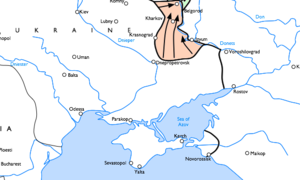
Back معركة خاركوف الثالثة Arabic Üçüncü Xarkov döyüşü Azerbaijani اۆچونجو خارکیف دؤیوشو AZB Трета битка при Харков Bulgarian Tercera batalla de Khàrkiv Catalan Třetí bitva o Charkov Czech Det tredje slag om Kharkov Danish Schlacht bei Charkow (1943) German Τρίτη μάχη του Χαρκόβου Greek Tria Batalo de Ĥarkovo Esperanto
| Third Battle of Kharkov | |||||||
|---|---|---|---|---|---|---|---|
| Part of the Eastern Front of World War II | |||||||
 German counteroffensives on the Eastern Front, February–March 1943 | |||||||
| |||||||
| Belligerents | |||||||
|
|
| ||||||
| Commanders and leaders | |||||||
| Units involved | |||||||
|
|
| ||||||
| Strength | |||||||
| 210,000 (at the start of Operation Star)[1] |
70,000 (Operation Star)[1] 120,000–130,000[2] (German counterattack) | ||||||
| Casualties and losses | |||||||
|
45,219 killed or missing 41,250 wounded[3] Total: 86,469 casualties |
4,500 killed or missing (SS Panzer Corps)[4] 7,000 wounded[4] Total: 11,500 casualties (SS Panzer Corps) | ||||||
The Third Battle of Kharkov was a series of battles on the Eastern Front of World War II, undertaken by Nazi Germany's Army Group South against the Soviet Red Army, around the city of Kharkov between 19 February and 15 March 1943. Known to the German side as the Donets Campaign, and in the Soviet Union as the Donbass and Kharkov operations, the German counterstrike led to the recapture of the cities of Kharkov and Belgorod.
As the German 6th Army was encircled in the Battle of Stalingrad, the Red Army undertook a series of wider attacks against the rest of Army Group South. These culminated on 2 January 1943 when the Red Army launched Operation Star and Operation Gallop, which between January and early February broke German defenses and led to the Soviet recapture of Kharkov, Belgorod, Kursk, as well as Voroshilovgrad and Izium. These victories caused participating Soviet units to over-extend themselves. Freed on 2 February by the surrender of the German 6th Army, the Red Army's Central Front turned its attention west and on 25 February expanded its offensive against both Army Group South and Army Group Center. Months of continuous operations had taken a heavy toll on the Soviet forces and some divisions were reduced to 1,000–2,000 combat-effective soldiers. On 19 February, Field Marshal Erich von Manstein launched his Kharkov counterstrike, using the fresh II SS Panzer Corps and two panzer armies. Manstein benefited greatly from the massive air support of Field Marshal Wolfram von Richthofen's Luftflotte 4, whose 1,214 aircraft flew over 1,000 sorties per day from 20 February to 15 March to support the German ground troops, a level of airpower equal to that during the Case Blue strategic offensive a year earlier.[5]
The Wehrmacht flanked, encircled, and defeated the Red Army's armored spearheads south of Kharkov. This enabled Manstein to renew his offensive against the city of Kharkov proper on 7 March. Despite orders to encircle Kharkov from the north, the SS Panzer Corps instead decided to directly engage Kharkov on 11 March. This led to four days of house-to-house fighting before Kharkov was recaptured by the SS Division Leibstandarte on 15 March. The German forces recaptured Belgorod two days later, creating the salient which in July 1943 would lead to the Battle of Kursk. The German offensive cost the Red Army an estimated 90,000 casualties. The house-to-house fighting in Kharkov was also particularly bloody for the German SS Panzer Corps, which had suffered approximately 4,300 men killed and wounded by the time operations ended in mid-March.
Cite error: There are <ref group=note> tags on this page, but the references will not show without a {{reflist|group=note}} template (see the help page).
- ^ a b Glantz, David M. (2014). From the Don to the Dnepr: Soviet Offensive Operations, December 1942 – August 1943. Routledge. p. 153. ISBN 9781135181307.
- ^ Glantz, David M. (2014). From the Don to the Dnepr: Soviet Offensive Operations, December 1942 – August 1943. Routledge. p. 226. ISBN 9781135181307.
- ^ Glantz & House 1995, p. 296.
- ^ a b Cite error: The named reference
Reynolds10was invoked but never defined (see the help page). - ^ Hayward 1998, pp. 330–331.